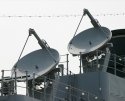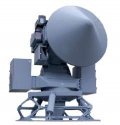In order for a proper conversation on the subject of radar and the frequency of choice it is important to relate it to the context of the overall conversation. In this case we are discussing the Type 055 and correspondingly the Arleigh Burke (AB) as a reference point since very little is known of the Type 055 and its capabilities.
The role of the AB amongst many things include the provision of area air defense against ballistic missiles and other air threats. Needless to say, it includes provision for self-defense. The nature of the diversity of threats warrant a suite of capabilities rather than a one size fits all approach. The NATO Anti-Air Warfare System (NAAWS) study and other studies established that X-band AESA-based radar was considered optimal for shipboard self-defense (horizon search). The choice of X-band frequency provided favourable low-altitude propagation characteristics, narrow beamwidth for track accuracy, wide operating bandwidth, and the ability to support target illumination for guided missile engagements. However for longer range engagements necessary for area air and missile defense lower frequencies such as S or C bands would be more optimal given the need to cover a much larger search area and engagement distance. It is not surprising that high end escort platforms like the AB have both S and X band radars.
When we engage in a discussion about the type of sensors needed it is important to pair the conversation to the nature of the threat and the type of missile under consideration. In the case of ESSM, it is primarily short to medium range self defense and the missiles are guided by the X band radar. With Block 2 ESSM which is slotted to go IOC in 2020, X band guidance is no longer needed as it comes with a dual mode seeker. In the case of long range engagements such as with SM-6, the guidance is via S band with terminal homing due to the long range and the nature of the threat such as ballistic missiles. The argument seems to me is that S band is incapable of providing sufficient resolution to engage the long range target.
In the case of the AMDR (SPY-6), there are enough public information to establish its capability. Against warhead and missile targets the AMDR would likely see a somewhat larger (roughly a factor of three) target radar cross-section due to its lower operating frequency. The new AMDR-S antenna area is about 75% greater than the area of the current SPY-1 antenna. If it operates at the 3.3 GHz frequency, its gain will also increase by about 75%. The AMDR-S gains about a factor of three in S/N relative to the current Aegis radar simply due to its larger antenna. The remaining factor of ten to get a total factor of about 15 dB = 32 is from increased average power (GAN based) and decreasing the system temperature and system losses. In the John Hopkins publication, S-band was assessed to provide acceptable performance for much lower cost than an X-band (~10 GHz) system at the same sensitivity and field of view. Trade study analysis indicated that although discrimination performance at X-band would be superior, it was not sufficiently better than the performance at S-band to justify the cost differential. (source : Page 149 Johns Hopkins APL Technical Digest, Volume 34, Number 2 (2018)
I don't know how it is possible to hold a conversation about this topic when you don't seem to have a working understanding of the various guidance and fire control concepts on other ships in the world.
It seems like you're doing some research around the topic as we're discussing it but only oriented towards the Burke class ships, the SPY-6 and SPY-1, and US missile systems used aboard those ships.
But if you're trying to have a discussion about what 052C's guidance and fire control concept is (and by extension, that of 052D, 055 etc), you need to have a working understanding of how the major other ship types operate as well. Type 45, Horizon, Grigorovich, FREMM, Kolkata, Sachsen/De Zeven class, all feature guidance concepts which require a working understanding. Those ships are
all relevant reference points if we want to discuss what 052C's guidance and fire control concept is.
You're doing a great job quoting documents and articles that you've looked up, but it is completely irrelevant to the argument you're trying to make.
For example -- yes, it's basic knowledge that Block II ESSM and SM-6 do not need terminal illuminators (which, if I'm not sure I need to spell out for you -- operate in the X band) because they are ARH, and I've written statements to that extent in previous posts as well.
But there is a reason why the first batches of Flight III Burkes will retain their SPG-62 illuminators -- and that's because they'll still be using SARH guided missiles (like older SM-2 variants, and ESSM block I) which requires terminal illuminators that SPY-6 cannot provide.
The fact that you write about SPY-6's ability to provide guidance for ARH missiles as if it is "news" without knowing that there are multiple other guidance/radar systems in S band in the world which already offer it (SAMPSON, EMPAR, MF STAR) is rather revealing.





